This page contains affiliate links. We may earn money or products from the companies mentioned in this post through our independently chosen links, which earn us a commission. Learn More
The ancestor of every domestic canine is the Wolf. Yes, even that tiny Chihuahua that fits in your pocket is a direct descendant of Canis lupus.
Indeed, it is a specimen that draws great curiosity and awe. The wolf is regarded as a spiritual symbol, an apex predator and, overall, a majestic beauty.
Wolves have been bred with domestic dogs in a bid to bring that bit of wild into the household. This isn’t as easy as one would think, though. Wolfdog hybrids tend to be difficult, with skittish, unpredictable and dangerous temperaments.
Luckily, there are dogs that look like wolves but have stable personalities and make wonderful family pets. We’ll share a list of 23 of them right here. Let’s dive in!
Contents & Quick Navigation
What’s the Difference Between Wolf Dog Mix & Wolf-Like Dog?

German Shepherd Wolf Mix
The biggest difference between wolfdogs and dogs that merely look like a wolf is the temperament.
When you introduce the genes of a wild animal, expect some of those traits to shine through in the offspring.
Wolves are brilliant predators that survive in harsh environments and roam in packs. A wolfdog mix may be destructive in the yard, digging holes in the garden to “den” or urinating on inanimate objects frequently to mark territory.
They tend to exhibit predatory behavior, and should never be left alone around smaller animals or children.
Wolfdogs are also shy and skittish, especially around strangers. When feeling threatened, they might attack out of defense.
Wolf-like dogs come from completely different backgrounds altogether. The only thing they share with a Wolf is the appearance. The personality is more widely understood and the characteristics are stable. These breeds are domestic dogs through and through.
In this video you can compare a Wolfdog to a full-grown Siberian Husky to get an idea of its size and appearance.
Wolf Dog Hybrids
Here is a mini list of different crossbreeds, each with a Wolf parent.
- Husky Wolf Mix
- Wolamute Wolf Dog
- Czechoslovakian Wolf Dog
- Saarloos Wulfhund
- Kunming Wolf Dog
- German Shepherd Wolf Mix
23 beautiful dog breeds that look like wolves
1. Alaskan Malamute
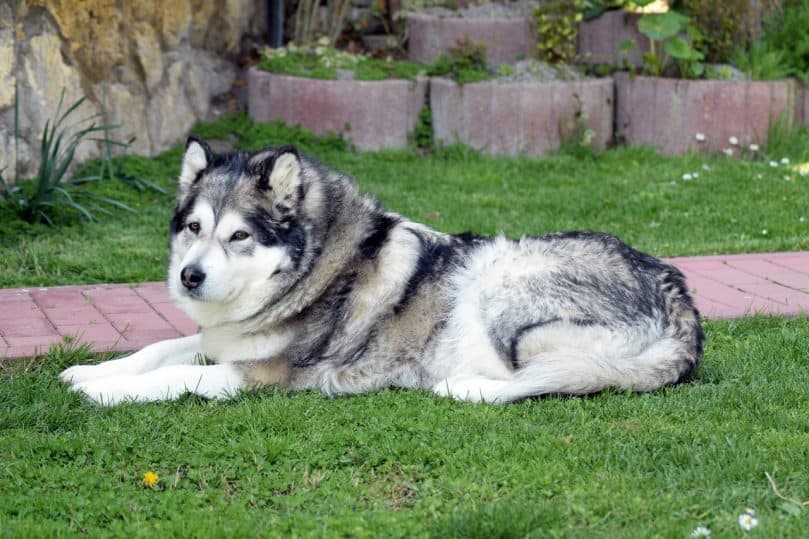
Alaskan Malamute
The Alaskan Malamute is part of the Husky family. This is a purebred dog, noted for its size and power. Like the Wolf, this dog is large in size, with a triangular face, long snout and pointed ears.
The Malamute is a working dog with high intelligence. She is easy to train and eager to please.
The Malamute is a lover at heart, preferring to be around family at all times. Despite her wolfish appearance, she is gentle around children.
Since this breed sticks to family members like glue, separation anxiety can become an issue if left alone for more than 4 hours. This can lead to destructive behavior such as digging and chewing.
2. Siberian Husky
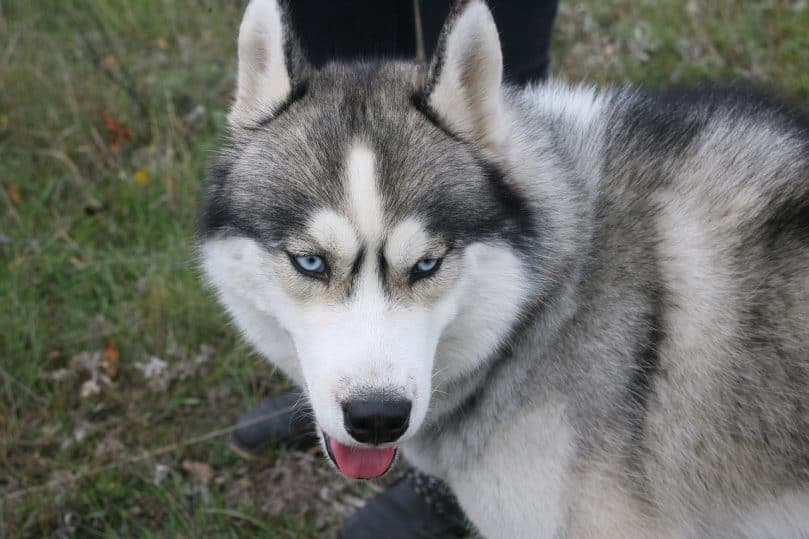
Siberian Husky
The Siberian Husky is one of the most popular family dogs due to its easy going persona.
She has the same pointed ears, long face, and thick coat of fur as the wolf, but one defining feature of the Husky is her ice-blue eyes.
This working dog is also used to pull sleds in the snow, so she is used to taking orders and getting the job done.
Intelligent and ready to obey, this breed is a breeze to train and will stick by your side no matter what. She is also not shy like wolfdogs tend to be. The Husky is a canine socialite who loves to be around adults, children and other pets.
3. Kugsha

Kugsha: Source
Also known as the Amerindian Malamute, this working dog from the North is used for pulling heavy freight and carts.
The Kugsha is a purebred dog with features that give it a wolf-like vibe. This is a big dog, with pointed ears, a long, wide face and a long bushy tail. Its shaggy coat sheds big time and requires daily brushing to keep loose fur at a minimum.
With the intelligence to lead a pack, the drive to take on any job and die-hard loyalty, you can trust the Kugsha to be a dependable companion and family dog.
Please be aware that this breed is dominant, so it will test its owner to see who’s the boss.
4. Samoyed
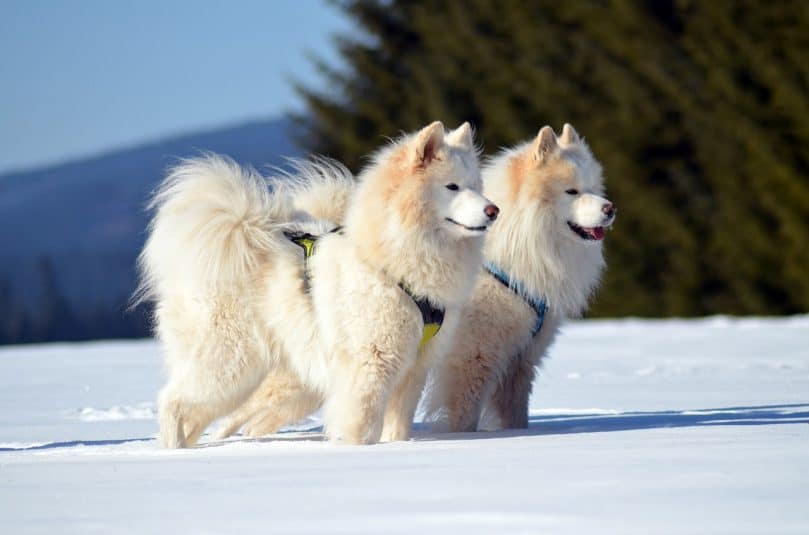
Samoyed
Hailing from Siberia, the Samoyed is a working dog with a special relationship to humans. They were originally bred by the Samoyede people, who used these dogs for tracking, packing, hunting, and to sleep on top of them for warmth at night.
This purebred looks like a majestic white wolf, but when you witness the famous “Sammy smile” you’ll know this is a big ol’ lovable hound and not some wild animal.
Families love the Samoyed. It adores children and has been known to dote on one family member in particular.
This breed is highly intelligent and ambitious. Keep her busy with challenges and exercise or else you can expect destructive behavior. The Samoyed is also a big talker and will not fail to voice her feelings with howls, barks, and bellows.
5. Tamaskan
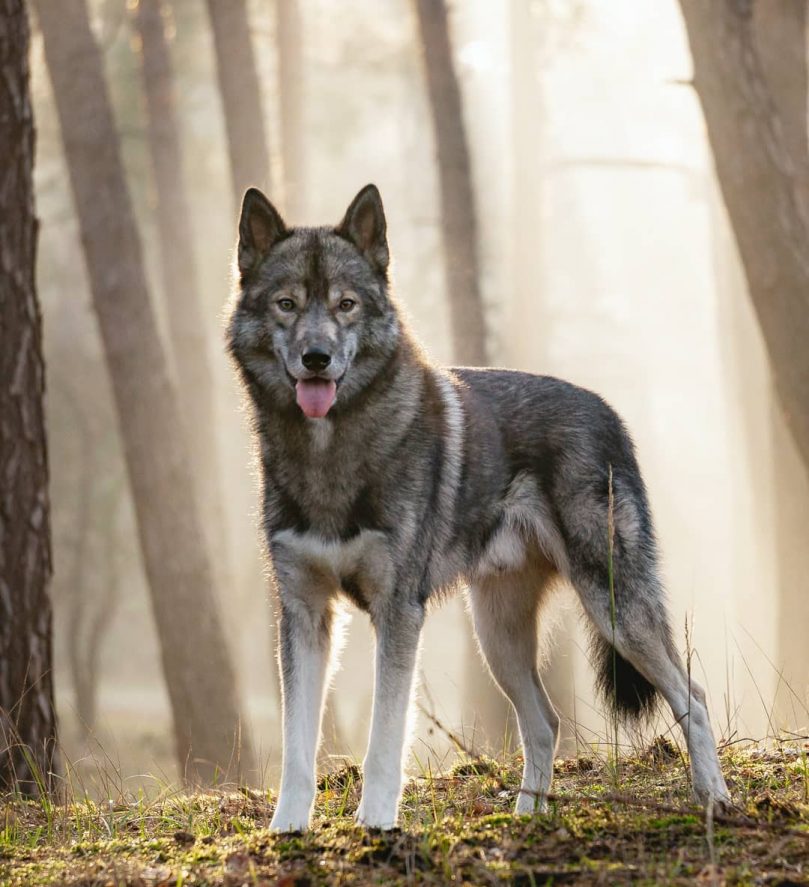
Tamaskan: Source
Meet the Tamaskan, a Wolf-like dog originating from Finland. Similar to the Husky breeds, she was bred to be a working dog with a tenacious disposition.
Tall and lanky with long legs and the signature Wolf-shaped head, the Tamaskan is a beautiful dog with stunning yellow eyes.
This breed is wonderful with children and other pets. She will stick by your side, ready to deliver kisses and snuggles on demand.
As a working dog, the Tamaskan is intelligent, agile and strong. She excels at physical challenges and loves having a job to do. A key characteristic of this breed is that she is more laid-back and will not try to dominate like other working breeds.
Though mellow, the Tamaskan doesn’t like to be left alone. After 3 to 4 hours, separation anxiety can set in, resulting in destructive behavior.
6. Akita Inu

Akita Inu
The Akita Inu is a purebred dog from Japan. In a nutshell, this breed is loyal and affectionate with family, but can be aloof and unpredictable around strangers.
The beautiful Akita might be more cat-like than wolf in appearance. It has long, dainty legs with a streamlined body and a wide face accompanied by two pointed ears.
There are two Akita breeds: the Japanese Akita and the American Akita. The American breed is larger than the Japanese breed and features a wrinkled forehead that is not shared by the Japanese breed.
The American Akita coat comes in several different colors while the Japanese Akita only comes in white and red.
I mentioned that the Akita is cat-like, and this is mainly due to its unique temperament. She moves with a feline agility and loves to be clean. It’s not uncommon to see an Akita licking itself or searching for a spotless area of the house to take a nap.
Akitas are known for being friendly and lovable with family, but there is an unpredictable aggressive streak that has garnered them a reputation as a dangerous breed.
7. Shiba Inu

Shibu Inu
Perhaps the Shiba is less like a Wolf and more like a fox with its prick ears, triangular face and red coloring that matches the Akita.
The temperament can be difficult to handle, as Shiba is strong-willed and spirited. Training this dog is not easy, as she forges her own path deciding whether to obey commands or not. This breed is not recommended for first-time dog owners.
If you live in an apartment and need a smaller dog, the Shiba is a good choice.
8. Shikoku Dog
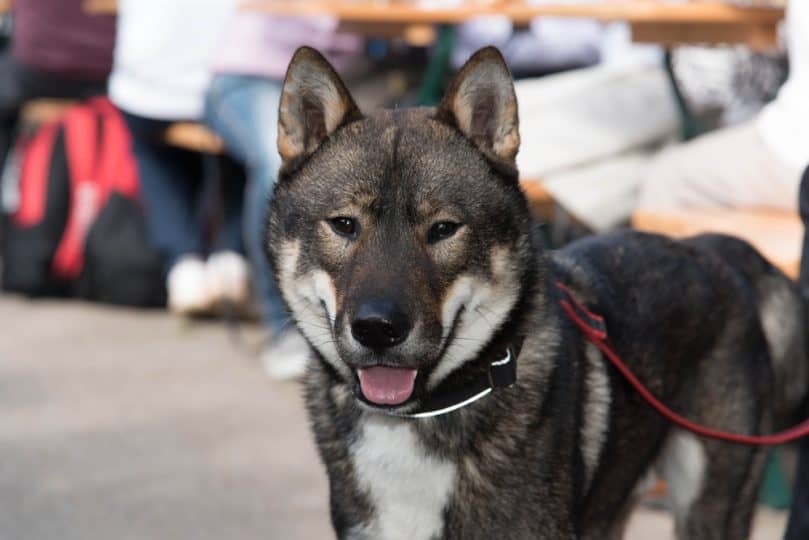
Shikoku
The Shikoku dog is yet another high-profile dog from Japan. This purebred canine loves the outdoors and has a strong relationship with nature. It is cautious and brave, loyal and easy to train.
The Shikoku resembles the Akita and Shiba in build, but in my opinion, it is the most wolf-like of the three breeds. Mainly this is because of the Shikoku’s love of the outdoors and its coat colors, which stray away from the distinctive red and white markings of its cousins.
Instead, this breed sports of coat of beautiful brown, black, white and red hues.
This canine makes for a genial family dog, if it is trained consistently and socialized from birth. Shikoku loves to cuddle and be petted. She is temperate and does well with children.
There is an aloof and aggressive streak with this breed, especially towards other dogs, but this can be tamed with training.
9. Pomsky
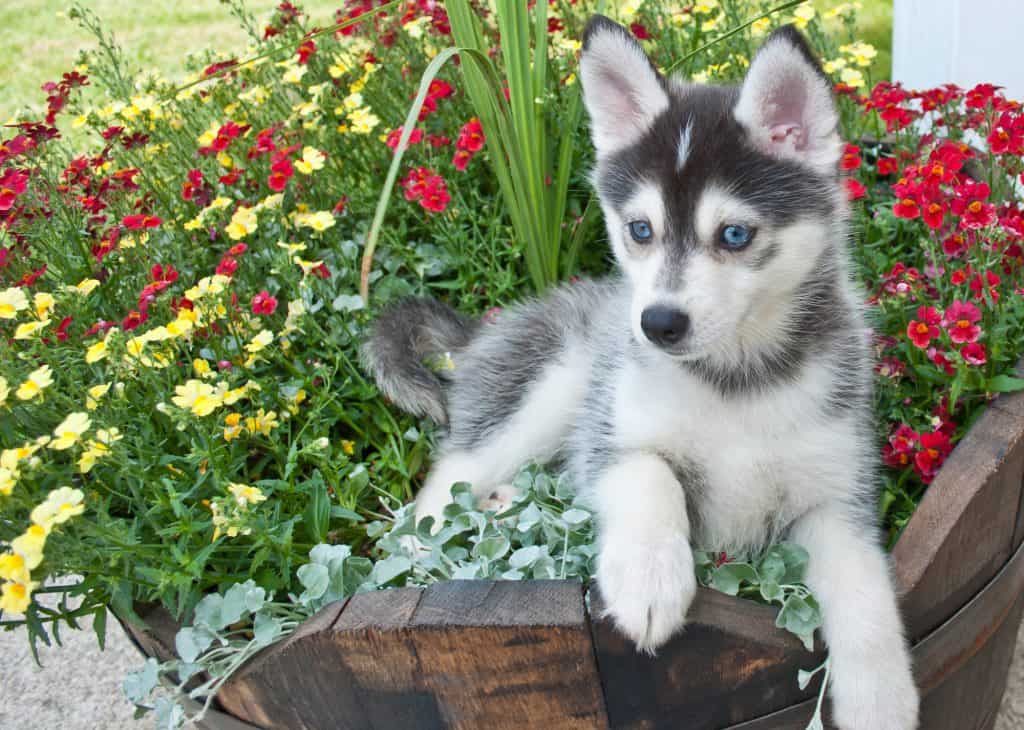
Pomsky
A Husky and Pomeranian were crossed to produce a tiny Husky (or, for the purpose of this article, a mini wolf).
Crossbreed caution: You never know what you’ll get. If you are hoping for a dog that looks like a wolf puppy its entire life, don’t set your expectations high. Hybrids are too unpredictable when it comes to appearance and temperament.
The Pomsky can be described as gentle, playful and low maintenance. A Pomsky full grown reaches a height of 15 inches (38 cm) and weigh up to 30 lbs (14 kg), making them a perfect alternative for apartment or city living.
Be careful if you have children or other dogs, because the Pomsky tends to be possessive of its owner. It also becomes stressed if handled too roughly- which is why small kids need to be carefully monitored when playing with this pup.
If this is the canine for you, be careful when researching Pomsky breeders, as it’s easy to fall into the hands of puppy mills if you’re not well informed.
10. Native American Indian Dog

Native American Indian Dog: Source
The Native American Indian Dog (NAID) is a rare breed that is just starting to gain popularity. Not only is it stunning with its wolf looks, but it has a wonderful nature, is highly intelligent and easy to get along with. Sounds like the perfect dog, right?
The NAID has a temperament of gold. Because of sharp thinking skills and an eagerness to please, this breed is preferred for service and therapy work. They learn quickly and do not need firm instruction to accomplish a task.
They love children and get along fine with other pets. Watch out for separation anxiety, as this breed doesn’t like to be alone for too many hours.
11. American Alsatian
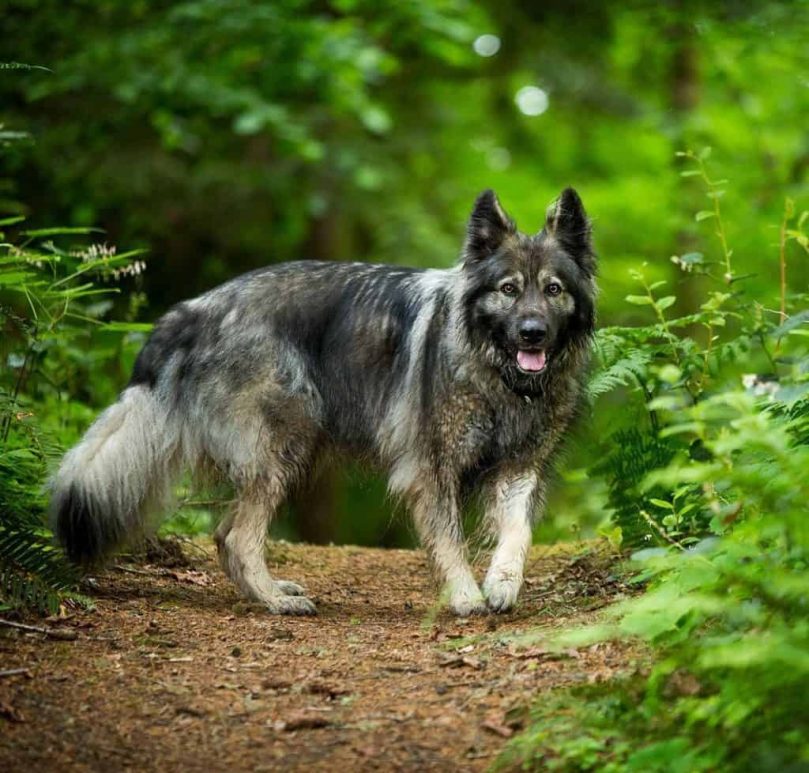
American Alsatian: Source
The American Alsatian is the product of a dream to breed a domestic dog that looks like a wolf but with a calm temperament. You might say this breed is the original quest for a wolf lookalike.
The American Alsatian is a cross between a purebred Alaskan Malamute and German Shepherd, with other dogs introduced into the mix later on. It is often referred to as a dog that looks like a dire wolf.
The result is an intuitive dog with affectionate qualities and a temperate demeanor. This is a quiet pet that doesn’t care to get loud or rowdy.
These easy going personality traits can be surprising when you see how big this fella is.
Make sure she has enough space to roam, meaning a fenced-in yard and not a tiny apartment.
12. German Shepherd
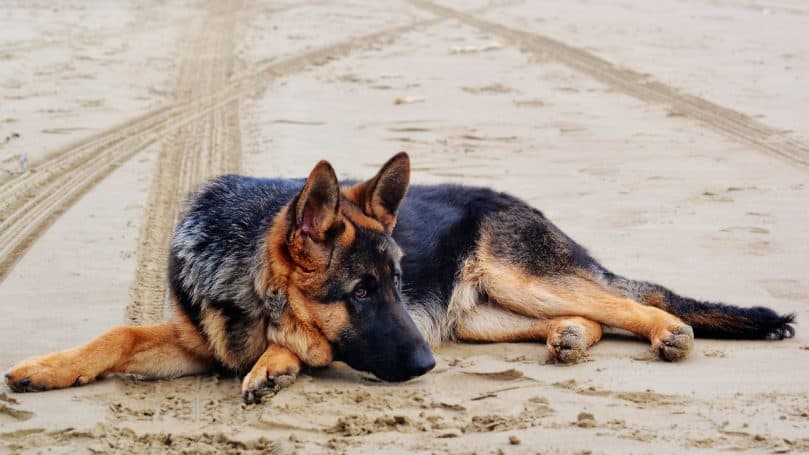
German Shepherd
The German Shepherd (GSD) is quite the superstar. Not only is it one of the most popular family dogs due to its remarkable qualities, but this purebred also shares a close resemblance to the wolf.
Large in size with a long body, pointed ears, and eyes that never miss a beat, the GSD is often used as a parent dog for wolf lookalike hybrids.
This is one of the most intelligent dog breeds, able to learn quickly, and excel at competitions. It is common to see the GSD used for service, police, and military work.
As a family dog, the GSD is protective and loving towards adults and children. She can be wary towards strangers, and may display aggressive behavior if afraid, uncomfortable or not socialized.
13. Finnish Lapphund
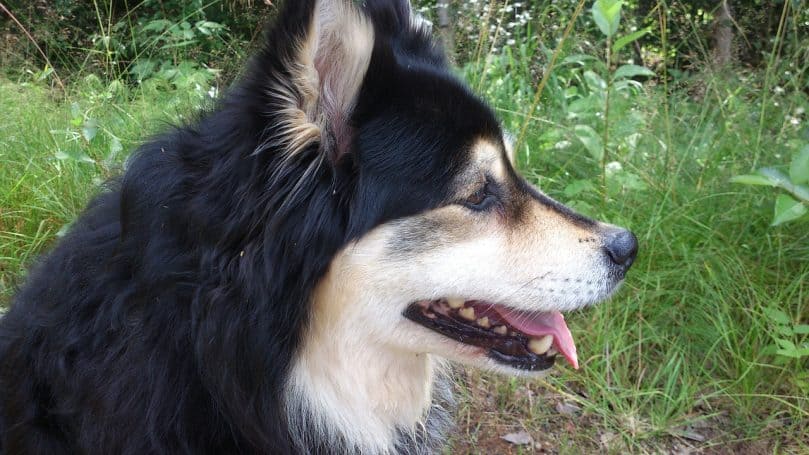
Finnish Lapphund
The Finnish Lapphund is all love and joy. She is especially fond of children and will do everything in her power to make them smile. In fact, this breed would rather flee the scene than attack when put in a threatened position. Gentle and kind is her nature!
This dog is hardworking and intelligent. Some say that the Finnish Lapphund plans out actions before executing them. This is also a vocal dog, who barks with a purpose in mind.
Adaptable, curious, and accustomed to life outdoors (she was bred to herd reindeer in Finland, once upon a time), the Finnish Lapphund is an excellent choice for first-time dog owners.
14. Swedish Vallhund
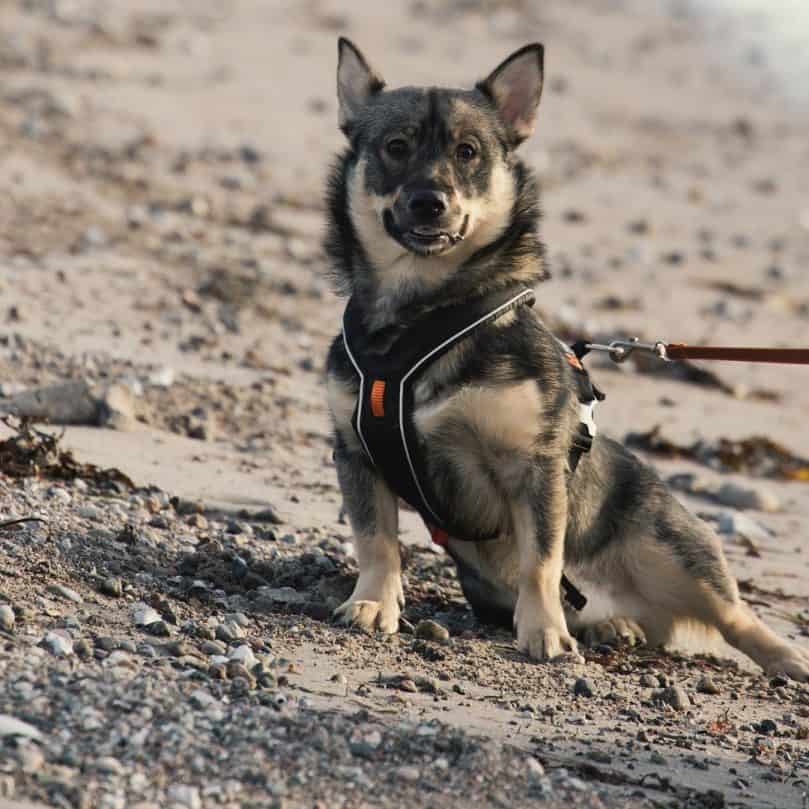
Swedish Vallhund: Source
If you’re the active type, then this might just be the wolf-like doggie companion for you. The Swedish Vallhund may be mid-sized, but has a huge personality and a whole lotta energy.
Bred for herding, this pooch loves to play and does not take well to sitting idle. Couch potatoes beware! She has been known to make up games to play not only to entertain herself when bored, but to entertain her human as well.
The Swedish Vallhund is also an enthusiastic barker, who will yap at the fly buzzing about the lamp, the mailman, and the squirrel in the oak tree. Of course, this can be controlled with training.
15. Alaskan Klee Kai

Alaskan Klee Kai: Source
The Alaskan Klee Kai may look like a Pomsky at first glance, but there are actually several differentiating features.
For one, the Alaskan Klee Kai is a purebred, while the Pomsky is a fairly new designer dog. The Klee Kai must have the face mask of the Alaskan Husky, while a Pomsky may have the face mask of the Siberian Husky (or not, since you never know with hybrids).
Nonetheless, the Klee Kai is an intelligent working dog that is active, playful and loves the outdoors. She is a people lover and makes a wonderful family pet.
She is shy around strangers, making her discomfort known through incessant whining. Never fear, training and socialization is the best way to nip it in the bud.
This is one of those dogs that look like mini wolves, so it is a solid fit for apartment life. Remember that daily exercise is needed to keep this hyper pup happy.
16. Greenland Dog
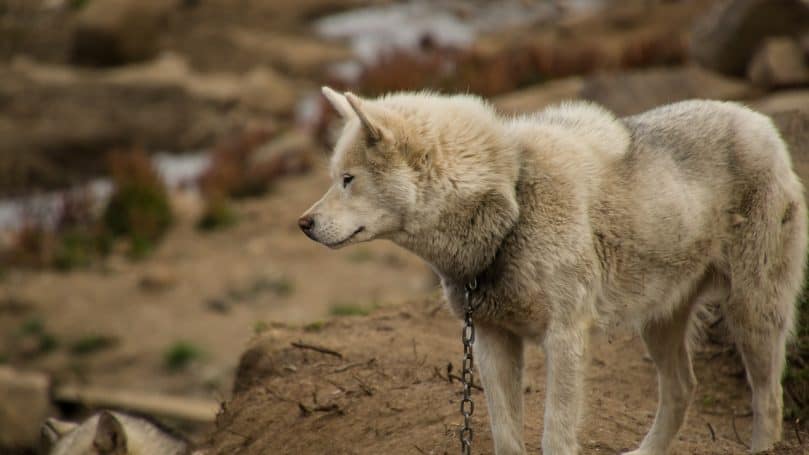
Greenland Dog
This breed is a Nordic dog, healthy and used to living in harsh conditions. It loves having a job to do and will become destructive if lounging for too long.
The Greenland Dog loves to roam, and requires plenty of space. It also has sharp predatory instincts, which it uses to hunt. It takes on the pack leader mentality and likes to assert dominance.
Because of these traits, it is not recommended to keep a Greenland Dog around children or other pets without supervision.
As well, this strong-willed pooch needs an experienced and patient owner who is not afraid to step up as the alpha.
The Greenland Dog may be aloof and independent, but is also loyal and affectionate towards family members.
17. Canadian Eskimo Dog

Canadian Eskimo Dog: Source
Some say the Canadian Eskimo Dog (CED) is the same as the Greenland Dog, while others reject the claim. Nonetheless, this working breed is prized as an intelligent and driven canine with a penchant for making a loving companion.
The CED was bred by the Thule people in the arctic nearly 4,000 years ago and was used to pull sleds and hunt. It was strictly considered a vital tool to get work done, never as a pet.
Years of life spent toiling in the brutal North shaped this large dog to be tough, hardy and disciplined. It has a higher prey drive than most breeds and needs to be active on a daily basis.
In modern times, the breed has declined in numbers, but exists now as a family dog. It is loyal and affectionate towards family, but must be supervised around children and other pets due predatory instincts.
18. Northern Inuit Dog
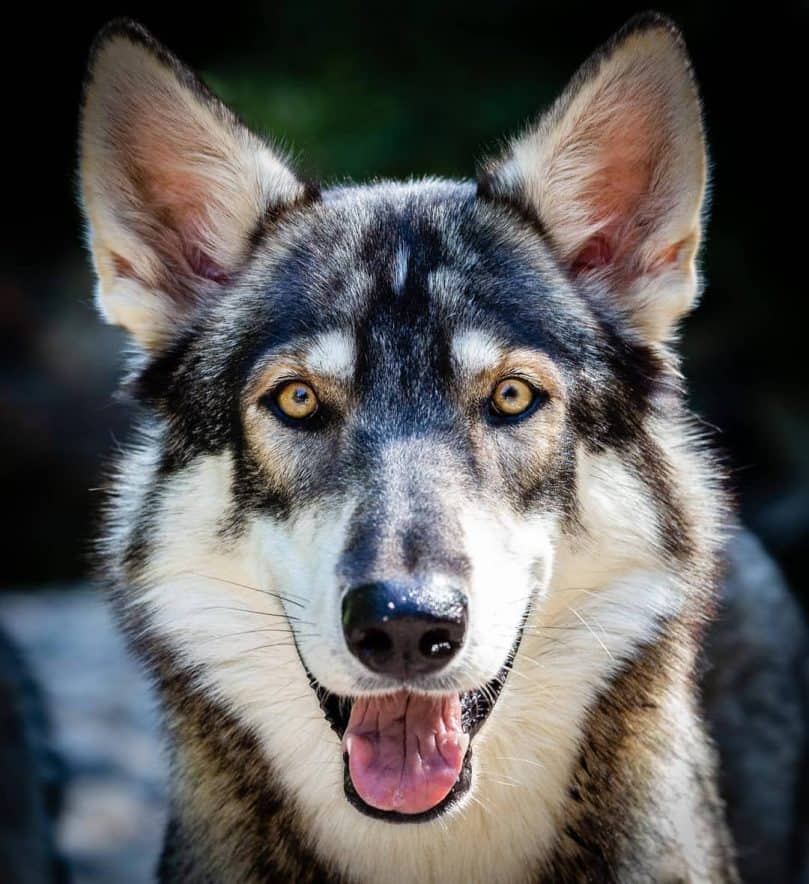
Northern Inuit Dog: Source
This is another crossbreed created in a bid to establish a gentle dog with a wolf appearance. It’s a mix of several dog breeds, including the German Shepherd, Alaskan Malamute, and Siberian Husky.
The Northern Inuit Dog is beautiful to behold, with a long, slender body, shorter coat than Husky dogs and striking yellow eyes.
This dog is dependable and relatively calm, making it a favorable family dog. It does need training to help shape model behavior. If left alone for long periods of time, it can get anxious and destructive.
Pack instincts can shine through as well. The owner of this type of dog needs to be confident and assertive – like a pack leader. If not, this breed will have difficulties following commands and will try to dominate other pets in the household. Early training and socialization is a must!
19. Utonagan
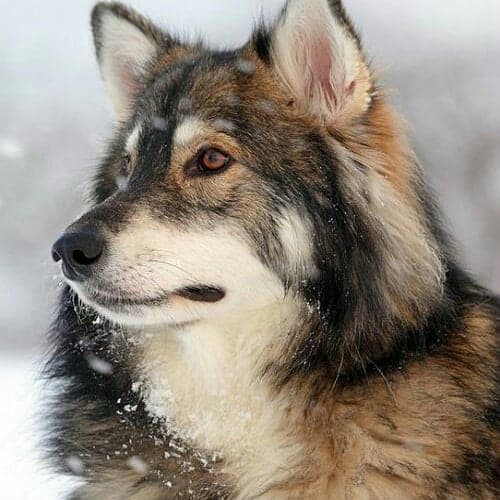
Utonagan: Source
There is some confusion surrounding the Utonagan and Northern Inuit Dog breeds. Some say they are the same. This is because the German Shepherd, Alaskan Malamute, and Siberian Husky are used to create both.
The different names emerged after dissidence. The first dog from this mix was the Northern Inuit Dog. A society formed to honor the new crossbreed, but some members disagreed on the specific traits that make the “perfect” wolf-like dog with a favorable temperament.
Some of the members left the club and began breeding Northern Inuit Dogs with other dog breeds. These new dogs were named Utonagan.
The remaining members of the society continued to breed using only Northern Inuit Dogs, and that is what they remained.
This breed is relatively calm with a kind disposition towards family and children. They are also intelligent, needing daily activity to thwart any destructive behavior.
20. Seppala Siberian Sleddog
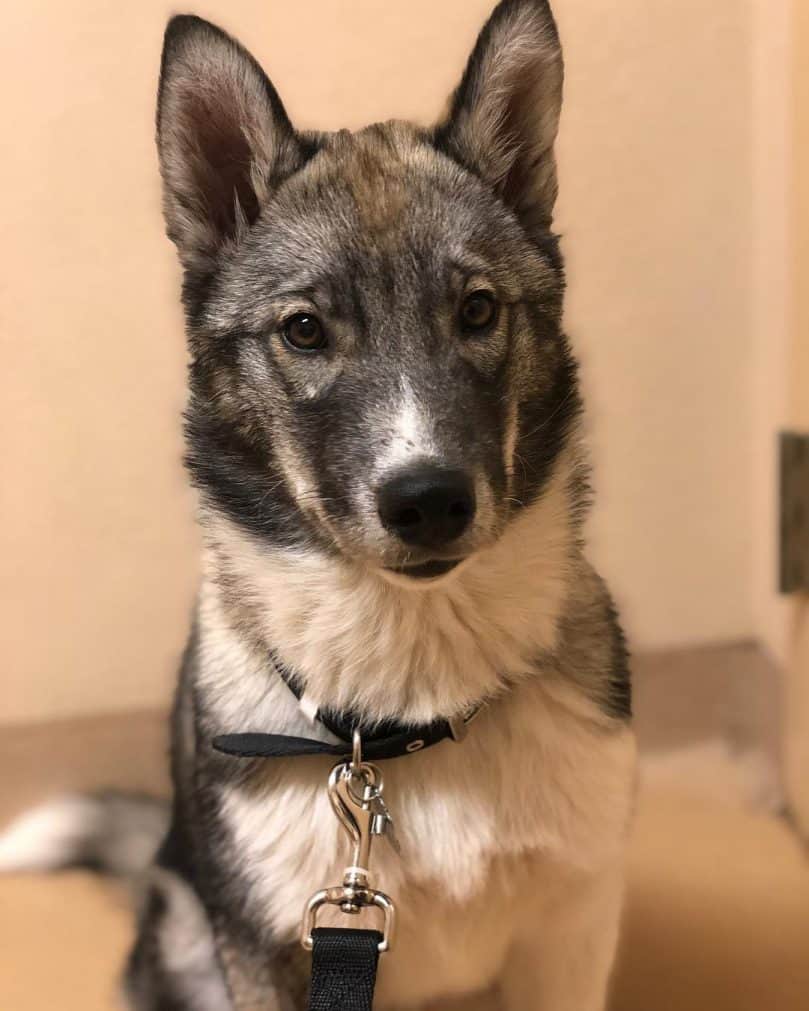
Seppala Siberian Sleddog
The beautiful Seppala shares the same breed heritage as the Siberian Husky. In fact, they used to be one and the same. Today, they are their own separate breeds due to appearance and purpose.
Huskies evolved over time to be show line dogs while, the Seppala has always been bred strictly as a working line dog. They need a lot of exercise and activity. After all, this breed is used to pulling heavy sleds!
The Seppala is docile and sweet by nature, but requires time and dedication to shape model behavior. This dog is high-energy and craves stimulation. Otherwise, she can be destructive, chewing up your precious belongings.
21. Belgian Tervuren

Belgian Tervuren
If you’re looking for a dog with a distinct look and elegant stance, get to know the Belgian Tervuren, a herding dog from Belgium.
She is a real charmer, with a confident air and sense of humor. Mid-sized with a dainty head and pointed ears, the Tervuren stands apart from the rest with her stunning mahogany coat.
This dog demands attention, and if she doesn’t get it, separation anxiety sets in. She loves to be around her human family and is always up for activities. This dog is go, go, go – but what would you expect from a working dog?
The Tervuren is intelligent and easy to train. It’s important to assert dominance so she won’t try to pull one over on you. Training is vital because as a herding dog, the instinct to chase is strong. She will go after the ducks at the park or the squirrels in the yard unless taught otherwise!
22. Groenendael
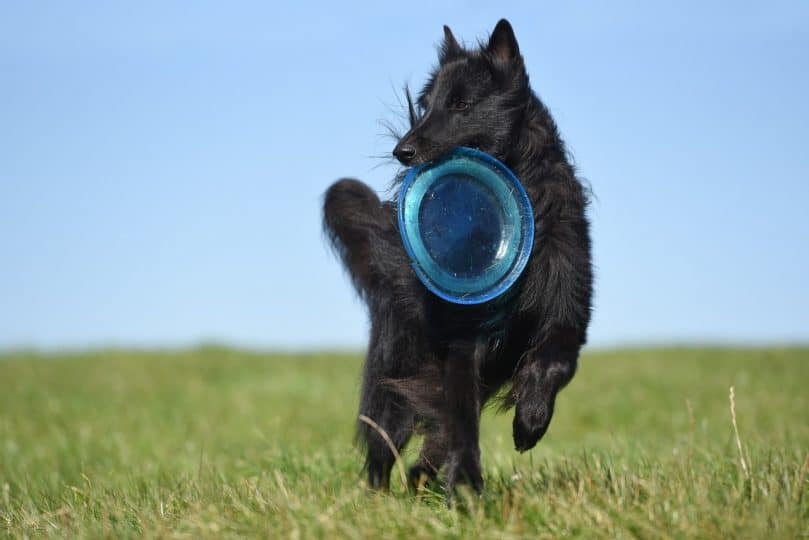
Groenendael
The lovely Groenendael is quite similar in appearance and temperament to its Belgian cousin, the Tervuren. The biggest difference is that this herding dog sports a lush, all black coat, making it look like a black wolf dog.
This dog is an athlete, with a muscular body and swift agility. Because of their physical prowess, along with high intelligence, they are commonly used for service work and in dog competitions.
The Groenendael is protective and will always keep an eye out for her family. They are brave and won’t hesitate to step up and defend with ferocity in lieu of a threat.
This is a high-energy pooch, so daily exercise and activities are needed to challenge her physically and mentally.
23. Alusky

Alusky: Source
The Alusky is a mix between a Siberian Husky and an Alaskan Malamute. Since it is a hybrid, it’s best to look at the characteristics of the parents to get a clear picture of how an Alusky puppy will possibly look and act.
In general, this crossbreed is known to be social and energetic. Their working dog background means that they love to take on jobs. The Alusky is a star when it comes to service and therapy work, rescue, and sledding races.
This is a loving family dog that does well around children.
You’ll want to offer plenty of play time in a fenced-in backyard, as they need room to roam and burn off bundles of energy.
Our favorite wolf-like dogs comparison table
To make it easier for you to choose among all these dogs that look like wolves, here’s a table that compares their various traits.
| Dog Breeds | Size | Top Traits | Lifespan | Shedding Level |
| Alaskan Malamute | Height: 26 in (66 cm); Weight: 95 lbs (43 kg) | Intelligent, good around kids | 12 to 16 years | Heavy |
| Siberian Husky | Height: 23 in (60 cm); Weight: 60 lbs (27 kg) | Family dog, high energy | 12 to 15 years | Moderate |
| Kugsha | Height: 27 in (68 cm); Weight 110 lbs (49 kg) | Family dog, dominant | 12 to 14 years | Heavy |
| Samoyed | Height: 23 in (60 cm); Weight: 65 lbs (30 kg) | Ambitious, good around kids | 12 to 15 years | Heavy |
| Tamaskan | Height: 28 in (71 cm); Weight: 99 lbs (45 kg) | Laid-back, family dog | 14 to 15 years | Light |
| Akita Inu | Height: 26 in (66 cm); Weight:120 lbs (54 kg) | Aloof, loyal, dangerous | 11 to 15 years | Moderate |
| Shiba Inu | Height: 16 in (41 cm); Weight: 25 lbs (11 kg) | Confident, stubborn | 12 to 15 years | Moderate |
| Shikoku Dog | Height: 21 in (52 cm); Weight: 50 lbs (26 kg) | Loyal, easy to train, aloof | 10 to 12 years | Moderate |
| Pomsky | Height: 15 in (38 cm); Weight: 30 lbs (14 kg) | Possessive, playful | 12 to 14 years | Heavy |
| Native American Indian Dog | Height: 34 in (67 cm); Weight: 120 lbs (55 kg) | Intelligent, good around kids | 14 to 19 years | Moderate |
| American Alsation | Height: 28 in (71 cm); Weight: 120 lbs (55 kg) | Family dog, calm | 12 to 14 years | Moderate |
| German Shepherd | Height: 26 in (65 cm); Weight: 85 lbs (40 kg) | Intelligent, loyal, protective | 13 years | Heavy |
| Finnish Lapphund | Height: 20 in (52 cm); Weight: 52 lbs (24 kg) | Good with kids, barks a lot | 12 to 14 years | Heavy |
| Swedish Vallhund | Height: 16 in (40 cm); Weight: 35 lbs (15 kg) | Playful, barks a lot | 12 to 14 years | Light |
| Alaskan Klee Kai | Height: 17 in (42 cm); Weight: 23 lbs (10 kg) | Family dog, whining | 14 years | Moderate |
| Greenland Dog | Height: 25 in (64 cm); Weight: 70 lbs (32 kg) | Healthy, predatory instincts | 13 years | Heavy |
| Canadian Eskimo Dog | Height: 29 in (73 cm); Weight: 88 lbs (40 kg) | Family dog, predatory instincts | 12 to 13 years | Heavy |
| Northern Inuit Dog | Height: 32 in (81 cm); Weight: 110 lbs (50 kg) | Dependable, calm | 12 to 14 years | Moderate |
| Utonagan | Height: 28 in (71 cm); Weight: 90 lbs (41kg) | Calm, intelligent | 10 to 15 years | Heavy |
| Seppala Siberian Sled Dog | Height: 23 in (58 cm); Weight: 50 lbs (23 kg) | Working lines, high energy | 12 to 16 years | Heavy |
| Belgian Tervuren | Height: 26 in (66 cm); Weight: 75 lbs (34 kg) | Intelligent, working dog | 12 to 14 years | Heavy |
| Groenendael | Height: 26 in (66 cm); Weight: 75 lbs (34 kg) | Intelligent, black coat | 12 to 14 years | Heavy |
| Alusky | Height: 28 in (71 cm); Weight: 90 lbs (41kg) | Family dog, energetic | 10 to 15 years | Heavy |
Conclusion: Which Dog That Looks Like a Wolf is For You?
You may love wolves so much that you want one as a pet, but it’s not as easy as finding a breeder, waving cash in the air and taking home a perfect puppy that doesn’t pee on the rug or chase the cat.
Wolf dog hybrids exist, but they are complicated to own as pets. They require the devotion of an experienced dog owner who has time to dedicate to intensive training.
As well, Wolf dog hybrids are unpredictable with the possibility of being aggressive.
Luckily, there are numerous dog breeds that have been bred to look like a wolf while retaining domestic traits that make them friendly, loving, and calm.
Which one do you like best? Tell us in the comments!

Leave a Reply